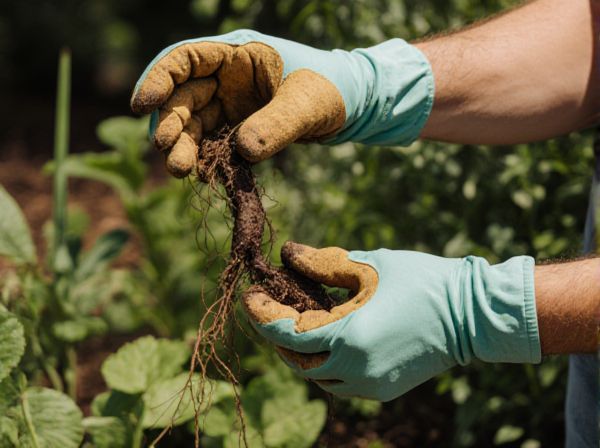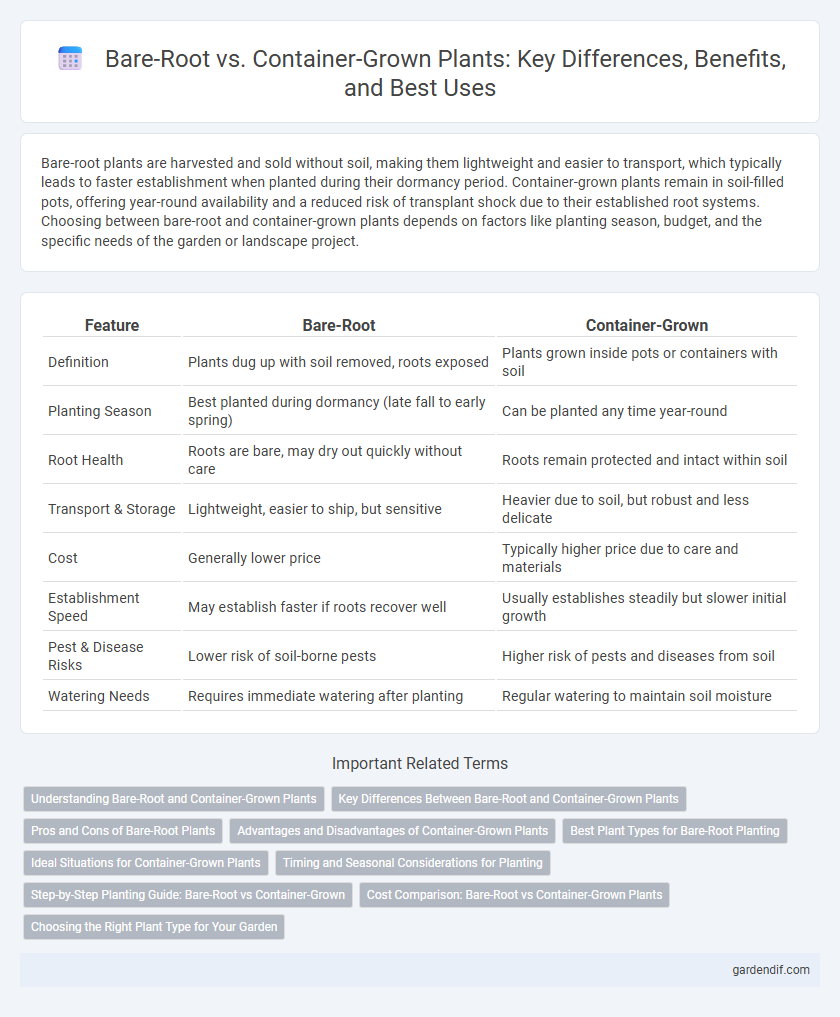
Bare-Root vs Container-Grown Illustration
Bare-root plants are harvested and sold without soil, making them lightweight and easier to transport, which typically leads to faster establishment when planted during their dormancy period. Container-grown plants remain in soil-filled pots, offering year-round availability and a reduced risk of transplant shock due to their established root systems. Choosing between bare-root and container-grown plants depends on factors like planting season, budget, and the specific needs of the garden or landscape project.
Table of Comparison
| Feature | Bare-Root | Container-Grown |
|---|---|---|
| Definition | Plants dug up with soil removed, roots exposed | Plants grown inside pots or containers with soil |
| Planting Season | Best planted during dormancy (late fall to early spring) | Can be planted any time year-round |
| Root Health | Roots are bare, may dry out quickly without care | Roots remain protected and intact within soil |
| Transport & Storage | Lightweight, easier to ship, but sensitive | Heavier due to soil, but robust and less delicate |
| Cost | Generally lower price | Typically higher price due to care and materials |
| Establishment Speed | May establish faster if roots recover well | Usually establishes steadily but slower initial growth |
| Pest & Disease Risks | Lower risk of soil-borne pests | Higher risk of pests and diseases from soil |
| Watering Needs | Requires immediate watering after planting | Regular watering to maintain soil moisture |
Understanding Bare-Root and Container-Grown Plants
Bare-root plants are sold without soil, featuring dormant roots that require careful handling and immediate planting to prevent drying out, commonly used for trees, shrubs, and perennials in cooler seasons. Container-grown plants are cultivated in pots with soil, offering year-round availability, easier transplant success, and reduced transplant shock due to intact root systems. Understanding the differences between bare-root and container-grown options helps gardeners select the best types based on planting season, climate, and long-term growth goals.
Key Differences Between Bare-Root and Container-Grown Plants
Bare-root plants are sold without soil, exposing the root system, which promotes easier inspection and reduces shipping weight compared to container-grown plants that are sold with soil intact inside pots. Container-grown plants maintain consistent moisture and root protection, enhancing transplant success and reducing establishment shock. Bare-root plants typically require planting during dormancy and can establish faster, while container-grown plants offer greater planting flexibility year-round and immediate visual growth.
Pros and Cons of Bare-Root Plants
Bare-root plants offer advantages such as lower cost, easier transportation, and quicker establishment since they are dormant and free of soil. However, bare-root plants require careful handling to prevent root desiccation and have a limited planting window, often best suited for early spring or late winter. Their growth can be slower initially compared to container-grown plants, which have established root systems and immediate access to nutrients.
Advantages and Disadvantages of Container-Grown Plants
Container-grown plants offer advantages such as year-round availability, easier handling, and reduced transplant shock due to established root systems. However, they may suffer from root-bound conditions and require more frequent watering and nutrient management compared to bare-root plants. The risk of soil-borne diseases and higher initial costs are additional disadvantages associated with container-grown plants.
Best Plant Types for Bare-Root Planting
Bare-root planting is ideal for deciduous trees, roses, and fruit trees like apples and cherries, as these plants establish quickly and develop strong root systems when planted dormant. This method reduces transplant shock and promotes vigorous growth, especially for perennials and shrubs with robust root structures. Container-grown plants are better suited for tropical species and delicate root systems requiring consistent moisture and temperature control.
Ideal Situations for Container-Grown Plants
Container-grown plants thrive in urban gardens and landscapes where immediate aesthetic impact and year-round planting flexibility are essential. These plants benefit from controlled root environments, reducing transplant shock and promoting quicker establishment compared to bare-root counterparts. Ideal situations include small spaces, patios, and areas requiring instant greenery or long growing seasons.
Timing and Seasonal Considerations for Planting
Bare-root plants require planting during dormant seasons, typically late fall to early spring, to ensure minimal stress and successful establishment. Container-grown plants offer greater flexibility, allowing planting throughout most of the growing season as they retain an intact root system and soil. Timing impacts root development; bare-root plants need careful handling and prompt planting, while container-grown specimens adapt more readily to varying seasonal conditions.
Step-by-Step Planting Guide: Bare-Root vs Container-Grown
Bare-root plants require soaking the roots in water for several hours before planting to ensure hydration and successful establishment, while container-grown plants can be planted directly without prior preparation. For bare-root plants, dig a hole wide and deep enough to spread the roots without crowding, then backfill with soil and water thoroughly to eliminate air pockets. Container-grown plants need careful removal from pots, gentle root loosening if root-bound, planting at the same soil level, and consistent watering to encourage root growth and stability.
Cost Comparison: Bare-Root vs Container-Grown Plants
Bare-root plants generally have a lower initial cost compared to container-grown plants due to reduced nursery maintenance and shipping expenses. Container-grown plants incur higher costs because of the need for potting media, containers, and extended care before sale. Long-term expenses may vary, as bare-root plants can require more initial labor for planting and establishment, but container-grown plants often benefit from quicker growth and reduced transplant shock.
Choosing the Right Plant Type for Your Garden
Selecting between bare-root and container-grown plants depends on your garden's soil quality and planting timeline. Bare-root plants, shipped without soil around their roots, prefer dormant-season planting and often establish faster with vigorous growth. Container-grown plants offer flexibility for year-round planting and reduced transplant shock but may require careful acclimation to prevent root-bound issues.
Bare-Root vs Container-Grown Infographic

 gardendif.com
gardendif.com